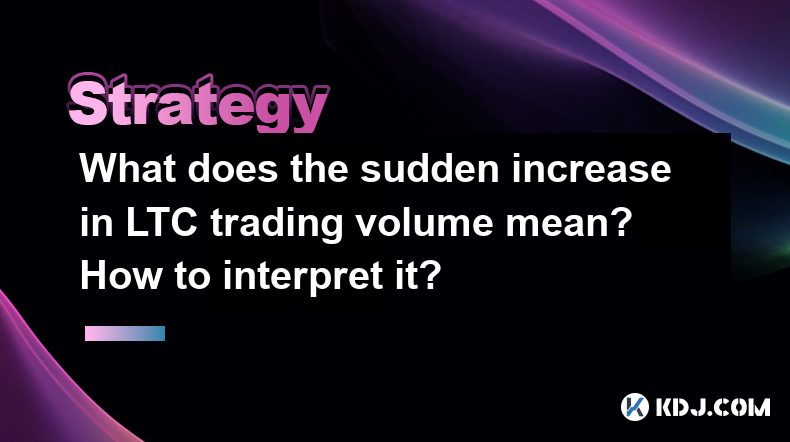-
 bitcoin
bitcoin $115692.075601 USD
5.13% -
 ethereum
ethereum $4162.931611 USD
11.68% -
 bnb
bnb $1310.063287 USD
17.56% -
 tether
tether $1.000983 USD
0.00% -
 xrp
xrp $2.534505 USD
8.16% -
 solana
solana $198.235737 USD
13.49% -
 usd-coin
usd-coin $1.000236 USD
0.02% -
 dogecoin
dogecoin $0.207352 USD
12.89% -
 tron
tron $0.323043 USD
3.62% -
 cardano
cardano $0.701559 USD
11.88% -
 hyperliquid
hyperliquid $39.924597 USD
8.30% -
 chainlink
chainlink $18.934457 USD
11.56% -
 ethena-usde
ethena-usde $1.000552 USD
0.02% -
 stellar
stellar $0.340575 USD
7.05% -
 bitcoin-cash
bitcoin-cash $545.011757 USD
8.86%
What does the sudden increase in LTC trading volume mean? How to interpret it?
A sudden increase in Litecoin trading volume can signal market dynamics and sentiment shifts, helping traders make informed decisions based on technical analysis and market context.
May 01, 2025 at 08:56 am

The sudden increase in Litecoin (LTC) trading volume can be a significant indicator of various market dynamics and investor sentiment. Understanding the reasons behind this surge and how to interpret it can help traders and investors make informed decisions. In this article, we will delve into the possible causes of increased LTC trading volume, how to analyze these changes, and what they might signify for the cryptocurrency market.
Causes of Sudden Increase in LTC Trading Volume
A sudden increase in Litecoin trading volume can stem from various sources. One primary cause could be significant news or events related to Litecoin. For instance, if there were announcements about technological upgrades, partnerships, or regulatory changes affecting Litecoin, these could drive increased trading activity as investors react to the news.
Another cause might be market sentiment shifts. If the overall sentiment in the cryptocurrency market becomes more bullish or bearish, this can lead to increased trading volume as investors either buy into the hype or sell off their holdings. For example, if Bitcoin, often seen as a bellwether for the crypto market, experiences a significant price movement, this can spill over to other cryptocurrencies like Litecoin.
Lastly, large trades by whales or institutional investors can also cause a sudden spike in trading volume. If a large holder decides to move a significant amount of LTC, this can create a ripple effect, prompting other traders to follow suit.
How to Interpret Increased LTC Trading Volume
Interpreting an increase in LTC trading volume involves looking at several factors. The first step is to compare the current volume to historical data. If the volume is significantly higher than usual, it indicates strong market interest. Tools like trading charts and volume indicators can help visualize this comparison.
Next, consider the price action alongside the volume increase. If the volume surge coincides with a price increase, it might suggest a strong bullish trend. Conversely, if the volume spike occurs during a price drop, it could indicate a bearish trend or a potential reversal.
It's also important to look at the broader market context. If other cryptocurrencies are experiencing similar volume increases, it might suggest a market-wide event or sentiment shift. However, if the volume increase is isolated to Litecoin, it might be more specific to LTC-related news or developments.
Using Technical Analysis to Confirm Volume Trends
Technical analysis can provide further insight into the implications of increased LTC trading volume. Volume indicators such as the Volume Weighted Average Price (VWAP) or the On-Balance Volume (OBV) can help confirm whether the volume increase is a bullish or bearish signal.
- VWAP calculates the average price of LTC weighted by volume. If the current price is above the VWAP, it suggests bullish momentum, whereas a price below the VWAP indicates bearish momentum.
- OBV measures buying and selling pressure by adding volume on up days and subtracting it on down days. An increasing OBV alongside rising volume can confirm a bullish trend.
Additionally, chart patterns and other technical indicators like Moving Averages, Relative Strength Index (RSI), and Bollinger Bands can be used in conjunction with volume data to provide a more comprehensive analysis.
Potential Implications for LTC Holders and Traders
For LTC holders and traders, an increase in trading volume can have several implications. If the volume increase is accompanied by a price surge, it might be a good time to consider taking profits. However, it's crucial to assess whether the price increase is sustainable or if it's a short-term spike driven by hype.
On the other hand, if the volume increase occurs during a price drop, it might present a buying opportunity. Investors who believe in the long-term potential of Litecoin might see this as a chance to accumulate more LTC at a lower price.
For short-term traders, increased volume can provide more liquidity and trading opportunities. However, it also means higher volatility, which requires careful risk management.
How to Monitor LTC Trading Volume
Monitoring LTC trading volume effectively requires the use of reliable tools and platforms. Here are some steps to follow:
- Choose a reputable cryptocurrency exchange that provides real-time data on trading volume. Popular exchanges like Binance, Coinbase, and Kraken offer detailed charts and volume data.
- Use trading platforms with advanced charting tools. Platforms like TradingView or Coinigy allow users to overlay volume indicators and other technical analysis tools on their charts.
- Set up alerts for significant volume changes. Many trading platforms allow users to set custom alerts for when trading volume exceeds a certain threshold.
- Stay updated with news and events. Websites like CoinDesk, CryptoSlate, and the official Litecoin blog can provide timely information on developments that might affect LTC trading volume.
Frequently Asked Questions
Q: Can a sudden increase in LTC trading volume be manipulated?A: Yes, it is possible for trading volume to be manipulated through practices like wash trading or spoofing. However, reputable exchanges have measures in place to detect and prevent such activities. It's important for traders to use trusted platforms and cross-reference volume data across multiple sources to mitigate the risk of manipulation.
Q: How does LTC trading volume compare to other cryptocurrencies?A: Litecoin's trading volume can be compared to other cryptocurrencies by looking at the total volume across major exchanges. Websites like CoinMarketCap provide a comprehensive view of trading volumes for various cryptocurrencies, allowing users to see how LTC stacks up against others like Bitcoin, Ethereum, and Ripple.
Q: Is there a specific time of day when LTC trading volume is highest?A: Trading volume for Litecoin, like other cryptocurrencies, can vary by time of day. Typically, volume tends to be higher during overlapping trading hours of major global markets, such as when the Asian and European markets are open simultaneously. However, specific patterns can vary, and traders should monitor volume trends over time to identify peak trading periods.
Q: How can I use increased LTC trading volume to improve my trading strategy?A: Increased LTC trading volume can be used to refine trading strategies in several ways. For instance, traders can use volume spikes to confirm entry and exit points for trades. Additionally, monitoring volume can help identify potential trend reversals or continuations. Combining volume data with other technical indicators can enhance the accuracy of trading signals and improve overall strategy performance.
Disclaimer:info@kdj.com
The information provided is not trading advice. kdj.com does not assume any responsibility for any investments made based on the information provided in this article. Cryptocurrencies are highly volatile and it is highly recommended that you invest with caution after thorough research!
If you believe that the content used on this website infringes your copyright, please contact us immediately (info@kdj.com) and we will delete it promptly.
- XRP Price Prediction: Weekend Rollercoaster or Rally?
- 2025-10-12 08:45:16
- Bittensor (TAO): Super Bullish Signals Point to Potential 2x Rally
- 2025-10-11 10:25:12
- Silver Price Correction: Navigating the Dip & Identifying Key SEO Keywords
- 2025-10-11 10:25:12
- Decoding Crypto Trends: Bittensor's Bull Run, Cardano's Dip, and LivLive's Presale Buzz in 'Uptober 2025'
- 2025-10-12 08:45:16
- MoonBull: The Crypto Meme Coin Promising 1000x Gains?
- 2025-10-11 10:30:01
- Crypto Payroll Revolution: Stablecoins, Altcoins, and the Future of Salary Payments
- 2025-10-11 10:30:01
Related knowledge

Practical parameter settings for a Bitcoin multi-timeframe moving average system
Sep 18,2025 at 10:54pm
Optimizing Timeframe Combinations for Bitcoin Trading1. Selecting appropriate timeframes is crucial when building a multi-timeframe moving average sys...

How can I filter out false breakouts in Dogecoin high-frequency trading?
Sep 22,2025 at 01:00am
Understanding False Breakouts in Dogecoin Trading1. A false breakout occurs when Dogecoin's price appears to move beyond a defined support or resistan...

Techniques for identifying tops and bottoms in the Bitcoin on-chain NVT model
Sep 20,2025 at 07:54pm
Understanding the NVT Model in Bitcoin Analysis1. The Network Value to Transactions (NVT) ratio is often described as the 'P/E ratio' of the cryptocur...

What does the surge in open interest in Bitcoincoin futures mean?
Sep 20,2025 at 11:18pm
Understanding the Surge in Dogecoin Futures Open Interest1. A surge in open interest within Dogecoin futures indicates a growing number of active cont...

How can I use the Ethereum USDT premium to gauge market sentiment?
Sep 18,2025 at 11:55pm
Understanding the Ethereum USDT Premium1. The Ethereum USDT premium refers to the price difference between USDT (Tether) traded on Ethereum-based plat...

What should I do if Ethereum staking yields decline?
Sep 20,2025 at 06:18am
Understanding the Causes Behind Declining Ethereum Staking Yields1. The Ethereum network transitioned to a proof-of-stake consensus mechanism with the...

Practical parameter settings for a Bitcoin multi-timeframe moving average system
Sep 18,2025 at 10:54pm
Optimizing Timeframe Combinations for Bitcoin Trading1. Selecting appropriate timeframes is crucial when building a multi-timeframe moving average sys...

How can I filter out false breakouts in Dogecoin high-frequency trading?
Sep 22,2025 at 01:00am
Understanding False Breakouts in Dogecoin Trading1. A false breakout occurs when Dogecoin's price appears to move beyond a defined support or resistan...

Techniques for identifying tops and bottoms in the Bitcoin on-chain NVT model
Sep 20,2025 at 07:54pm
Understanding the NVT Model in Bitcoin Analysis1. The Network Value to Transactions (NVT) ratio is often described as the 'P/E ratio' of the cryptocur...

What does the surge in open interest in Bitcoincoin futures mean?
Sep 20,2025 at 11:18pm
Understanding the Surge in Dogecoin Futures Open Interest1. A surge in open interest within Dogecoin futures indicates a growing number of active cont...

How can I use the Ethereum USDT premium to gauge market sentiment?
Sep 18,2025 at 11:55pm
Understanding the Ethereum USDT Premium1. The Ethereum USDT premium refers to the price difference between USDT (Tether) traded on Ethereum-based plat...

What should I do if Ethereum staking yields decline?
Sep 20,2025 at 06:18am
Understanding the Causes Behind Declining Ethereum Staking Yields1. The Ethereum network transitioned to a proof-of-stake consensus mechanism with the...
See all articles























![[4K 60fps] Anyway by Retropt (1 Coin) [4K 60fps] Anyway by Retropt (1 Coin)](/uploads/2025/10/13/cryptocurrencies-news/videos/k-fps-retropt-coin/68ec4f42a41d0_image_500_375.webp)


















































